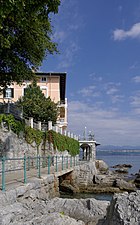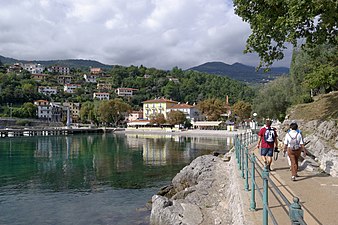Franz Joseph Promenade
The Franz-Joseph-Promenade , Serbo-Croatian: Obalno šetalište Franza Josefa I , also Lungomare , is a 12 km long promenade in the north-eastern Kvarner Bay near Rijeka . It is named after Emperor Franz Joseph I. The promenade leads from Lovran via Opatija to Volosko . The main town Opatija [ ɔˈpatiaː ] (Italian: Abbazia [aba'zia], German: Sankt Jakobi ) is a former, glamorous Austro-Hungarian seaside resort with large hotels from the imperial era. The z. The promenade, partly carved into the rock, with many preserved villas from the time of the Danube monarchy , is a main attraction of the three now Croatian seaside resorts.
history
The promenade along the mountainous and rugged seashore was designed in several stages by the local beautification association : first the northern part between Slatina and Volosko (completed in 1889), then the southern part to Lovran (1911). The initial resistance of the landowners involved could be overcome thanks to the authority of the district captain Jettmar.
designation
The promenade was initially named after the general director of the Südbahn , Friedrich Julius Schüler , who died in 1894 . With the beginning of Italian rule in 1918, it was renamed Lungomare Regina Elena , Lungomare della Madonna and finally Lungomare Principe Umberto . In the Yugoslav period from 1945 onwards it was called Matko-Laginja-Promenade . In the course of a general return in the former crown lands to the Habsburg heritage, which was valuable to tourists , it was named after Emperor Franz Josef I in 1996.
description
Along the Kaiser-Franz-Promenade you will find numerous architecturally remarkable villas and hotels, but also memorial plaques. Some examples (based on Volosko):
- Count Gyula Andrássy , Hungarian revolutionary and later Austro-Hungarian foreign minister, spent the last years of his life in the Villa Minach . He is said to have been visited incognito three times by Elisabeth of Austria-Hungary .
- The Littrow memorial commemorates Heinrich von Littrow , a now largely forgotten sailor and poet.
- Villa Ransonnet initially belonged to the biologist Eugen von Ransonnet-Villez and was later owned by Leo Kremesek.
- The former children's sanatorium in Szegö later became the Hotel Belvedere.
- The then famous violinist Jan Kubelík lived in Villa Rosalia .
- Villa Neptun, built between 1890–97 and stylistically based on Miramare Castle near Trieste , temporarily belonged to Countess Laura Henckel von Donnersmarck. Vladimir Nabokov spent a childhood summer here. The post-modern Hotel Miramar now stands on the site of the former magnificent garden .
- The Villa Ambasador once housed the New Sanatorium Franz Schalk (later: Sanatorium Lakatos ) and is now part of the complex of the Ambasador hotel high-rise built in the 1960s, a prestigious building from the Tito era (architect Zdravko Bregovac ).
- A plaque commemorates Henryk Sienkiewicz , who wrote a novella in Abbazia as a preliminary draft for his later novel "Quo vadis".
- A bust commemorates Friedrich Schüler, the general director of the Southern Railway Company , who promoted the expansion of Abbazia into a health resort.
- The promenade leads past Villa Angiolina through the center of the health resort with its Hotel Kvarner and the former princely dependance Villa Amalia.
- A relief by the surgeon Theodor Billroth that was destroyed in the Second World War was reconstructed and reassembled.
- To the southwest of the center of Opatija is the Villa Madonna or Villa Schalk, a casino since 2002. Emperor Franz Josef I and Katharina Schratt are said to have met several times in the villa built in 1891 .
- The Villa Glax was inhabited by the spa doctor Julius Glax, who was important for Abbazia's development .
- The neighboring Villa Ariston belonged to the daughter of Julius Glax and later to the Italian Prince Andrea Boncompagni.
- The once magnificent Villa Münz , built in 1903 for the building contractor and tram concessionaire Jakob Ludwig Münz, now appears to be abandoned
- The Villa Frappart is considered to be one of the most successful buildings by the architect Carl Seidl , who set the style for the region with his villa buildings.
- Franz-Joseph-Promenade from north (Volosko) to south (Lovran)
literature
- Amir Muzur: Opatija / Abbazia. Walk through space and time. Rijeka 2000.
Web links
Individual evidence
- ^ A b Christian Schüle: The emperor's new promenade. In: zeit.de, July 12, 2007, accessed on June 1, 2019.
- ↑ a b c d e f g h i j k l m n Lungomare - The coastal promenade on opatija.net (German), accessed on June 1, 2019.
Coordinates: 45 ° 19 ′ 55 ″ N , 14 ° 18 ′ 11 ″ E







